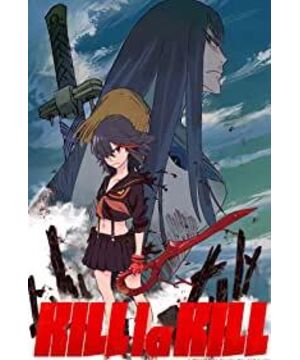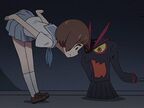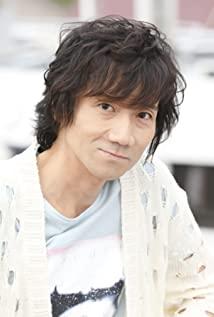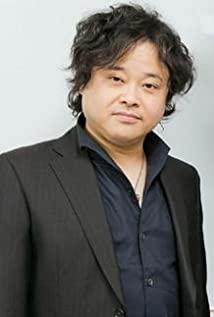I just finished watching this masterpiece, how excellent the work is, and the other answers are almost the same (it was so good that I bought a limited edition BD for the first time in my life), I said something different, that is, the use of classical music in KLK.
(About the core of the work and the so-called "problem of selling meat" that many people criticize, if you are interested, please move to the end)
Classical music often depicts magnificent, grand scenes or mourning, mourning atmospheres. It sounds like the complete opposite of violence, blood, and sin. But when the two are subtly blended together, it will produce a kind of ecstasy Fascinating beauty. I am obsessed with all the works of violent aesthetics, such as "A Clockwork Orange", "The Shining", "Silence of the Lambs", "Quick Preparation", etc. In fact, this is not a group of old hooligans This is the first time I did it, I tried it when I was doing "Evangelion" at Gainax. Whether it's Bach's "Aria on the G string" when Asuka battles the mass-produced machine, or when Shinji is most against Nagisa Kaoru" "Ode to Joy" has been well received by the industry and fans. However, the old hooligans have further developed in KLK and used more classical elements, which made me even more addicted to this work.
Briefly list the classical music I heard and the number of episodes in the works. There may be omissions, welcome to add.
1. The Blue Danube Waltz , Op. 314 ("The Blue Danube", Op.314), Johann Strauss Jr.
Episode 4, 13:30 sec. The school bus is blown away.
2. Small Talk Polka , Op. 214 (Tritsch-Tratsch, Polka schnell, Op. 214), Johann Strauss Jr.
Episode 5, 15:10 sec. Noone battle music.
3. Radetzky March, Op.228 (Radetzky March, Op.228), Johann Strauss the Elder
Episode 9, 0:00 seconds, the opening broadcast The decisive battle of Xuanxueyuan begins, and the eyes are full of the sense of sight of the middle school sports meeting.
4. March under the Double Eagle, Op.159 (Under the Double Eagle, Op.159), Josef Franz Wagner
Episode 10, 13:38 sec, School Battle Noone's Battle Song.
Episode 17, 17:18 sec, Opening Song of the School Sports Festival.
5. Light Cavalry Overture, Franz von Suppey
Episode 10, 14:52 sec, the first battle song after Naoine's outfit change.
6. William Tell Overture - finale, Gioachino Rossini
Episode 10, 18:30 seconds, after the memory of the encounter between Noine and Satsuki, Battle Hymn.
Episode 11, 0:00sec, starts with the previous episode.
7. Cancan , a dance music popular in France at the end of the 19th century
Episode 11, 2:45sec, After OP
Episode 16, 0:00 seconds, the speed of 1 minute and a half summed up the plot of the first 15 episodes, with cancan dance.
8. Symphony No. 5 in C minor, Symphony of Destiny , Op. 67, (Symphony No. 5 in C minor, Op.67), Beethoven
Episode 11, 7:28 seconds, the battle song after Noone Encore's return. Hiroshi Sawano vs Beethoven?
9. Pomp and Circumstance Marches, Op.39, Pomp and Circumstance Marches, Op.39, Edward Elgar
Episode 14, 10:46 seconds, the battle song of Noone's attack on Kyoto Academy.
10. Piano Sonata No.2 in B-flat minor - Chapter 3 / Funeral March (Piano Sonata No.2 in B-flat minor, Op.35. III), Chopin
Episode 4, 7:32 seconds, classmate Maiko broke her arm and fell to the ground, so sad.
Episode 24, 5:18 seconds, Yong Jun Ke was injured and fell to the ground, so sad. Mako will start in the next second.
I have found so much for the time being, and I will add it later if I find any omissions.
In addition, every time "Hallelujah" sounded, the strong contrast instantly brought my emotions into repulsion. I was angry and funny, I really like it.
Finally, Imaishi Hiroyuki NB, Sawano Hiroyuki NB.
Hallelujah!
About the core of the work:
It is about class and desire. Clothes represent class and also symbolize desire. At the beginning, Satsuki refused to desire and refused to obey clothes. She has been fighting desire by her own willpower. . Liuzi recognized desire and chose to coexist with it, so when he changed clothes, he was "one body with clothes". Luo Xiao, on the other hand, completely obeyed his desire, became a "slave of clothes", and tried to make the world a better place to be. The slave of making clothes (in a sense, she actually succeeded, but was killed). At the end of the story, Luo Xiao was defeated, and Satsuki's change of clothes also became "one body and clothes". The reality is like this, people It is impossible to have no desire, and it is not a bad thing to have desire. In fact, it is the existence of desire that has been promoting the development and progress of society and technology. As ordinary people, what we need to do is not to be swallowed by desire, but to be with it. Peaceful coexistence, friendly use of each other, and moving forward together. Only by "oneness in human and clothing" can we truly be a better version of ourselves and a better version of ourselves. "We are neither human nor clothing; but we are both human and Clothes".
Regarding meat sales:
At the beginning, Liuzi was shy because of her revealing clothes, so she couldn't play her combat power. Then she was taught by Satsuki: " Your so-called shame is just a child's play, and it will only make you unable to fight. " This sentence is simply a declaration of women's independence in the new era. The work completely abandons the female discourse that takes men as a reference. The women in the works have control over their own bodies, do not live under the shame of men, and will not be because of the so-called shame of men It is reserved, not to be a vase of male vassal. Pastoral feminists study hard. If you have time to feel ashamed, it is better to ask yourself where the shame comes from.
Hallelujah!
View more about Kill la Kill reviews











